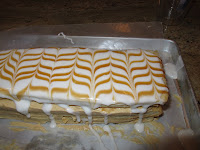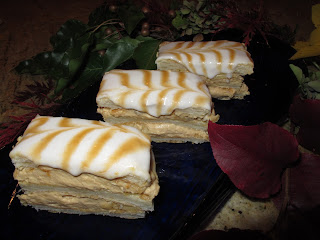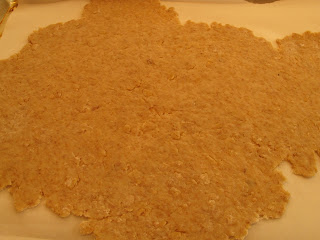Well, I have been living a lie.
For many years, I have been buying puff pastry instead of making it myself with the excuse that the frozen version actually tasted better than my homemade. I have never been good at the laminated (layered) dough. They always turned out a little tough.
But this month's challenge has changed my mind. I am never going back to frozen again.
Our October 2012 Daring Bakers’ challenge was hosted by Suz of
Serenely Full. Suz challenged us to not only tackle buttery and flaky puff pastry, but then take it step further and create a sinfully delicious Mille Feuille dessert with it!
I had a rough start because I tried to make the puff pastry on an afternoon when I was really tired, I was not in tune with the dough and as silly as it may sound, I firmly believe that you have to be empathetic to your dough to understand what it needs for success.
Here is a picture of the puff pastry failure. Note the oozing butter through the dough. That is not a good thing.
BUT it got better from there. I started on an afternoon when I was not tired and had no other real pressing tasks.
I decided early on in the month that I wanted to make a Caramel Apple Napoleon. It is Autumn here in New England and the apples are everywhere. The days are getting shorter in daylight time but the temperature is still mild. I wanted to make something homey but still light.
Here is the recipe for Puff Pastry as Suz wrote it. It is a great recipe if you follow her suggestions:
Puff Pastry:
Servings: Makes 8-10 mille-feuille (yields: 675g pastry)
Ingredients
1¾ cup (250g) plain/all-purpose flour
Scant ¼ cup (55 ml) (1¾ oz)(50g) unsalted butter, chilled and cubed
1 teaspoon (5ml) (6 gm) salt
½ cup plus 2 tablespoons (5/8 cup)(150 ml) cold water
14 tablespoons (210 ml) (7 oz) (200g) butter (for the beurrage), room temperature
3½ tablespoons (55ml) (30g) plain flour (for the beurrage)
Additional flour for rolling/turning
Directions:
1. Cut the larger quantity of butter into smallish pieces and set aside at room temperature.
2. Put the larger quantity of flour into a bowl with the salt and the cold, cubed butter.
3. Lightly rub the butter and flour between your fingertips until it forms a mealy breadcrumb texture.
4.Add the cold water and bring together with a fork or spoon until the mixture starts to cohere and come away from the sides of the bowl.
5. As the dough begins to come together, you can use your hands to start kneading and incorporating all the remaining loose bits. If the dough’s a little dry, you can add a touch more water.
6. Knead for three minutes on a floured surface until the dough is smooth.
7. Wrap in clingfilm and refrigerate for at least 30 minutes.
8. While the dough is chilling, take your room temperature butter and mix with the smaller amount of plain flour until it forms a paste.
9. Place the butter paste between two sheets of clingfilm, and either with a rolling pin or your hands (I found hands easiest) shape it into a 4.5”/12cm square. You can use a ruler (or similar) to neaten the edges.
10. Refrigerate for about 10-15 minutes so the butter firms up slightly. If it’s still soft, leave it a bit longer. If it’s too hard and inflexible, leave it out to soften a touch. You want it to be solid but still malleable.
11. Once the dough has chilled, roll it out on a floured surface into a 6”/15cm square. Place the square of butter in the middle, with each corner touching the centre of the square’s sides.
12. Fold each corner of dough over the butter so they meet the centre (you might have to stretch them a little) and it resembles an envelope, and seal up the edges with your fingers. You’ll be left with a little square parcel.
13. Turn the dough parcel over and tap the length of it with your rolling pan to flatten it slightly.
14. Keeping the work surface well floured, roll the dough carefully into a rectangle ¼ inch /6 mm in thickness.
15. With the longest side facing you, fold one third (on the right) inwards, so it’s covering the middle section, and ensure that it is lined up .
16.Then, fold the remaining flap of dough (on the left) inwards, so you’re left with a narrow three-layered strip.
17. Repeat steps 14, 15, 16.
18. Wrap up in clingfilm and chill for at least 30 minutes.
19. Repeat steps 14, 15, 16 twice.
20. Wrap up in clingfilm and chill again for at least 30 minutes.
21. Repeat steps 14, 15, 16 two final times.
22. Wrap in clingfilm and chill 30 minutes or until ready to use.
I made a Caramel Pastry Cream that was a little complicated but turned out delicious.
3/4 cup (6 oz,177ml)sugar
1/3 cup (80ml) water
1 1/3 cup (330ml)milk
2 large egg yolks
2 TBSP (1/2 oz, 14 gm) cornstarch
3/4 cup (6 oz,177ml) heavy/whipping cream
Preparation:
In a saucepan over medium-high heat, tilt and stir sugar with water until melted then turn heat to high and cook until amber-colored, 8 to 10 minutes. Pour onto a sheet of foil (about 12 by 18 in.) and let cool to room temperature, about 20 minutes. Peel off foil and break caramel into chunks; put in a food processor or blender and whirl into a fine powder. Try to use right away as it will clump if not. If it clumps, just disolve it a bit with the milk and proceed.

- Combine milk and caramel powder in a 1 1/2- to 2-quart pan; stir over medium heat just until caramel is dissolved (it will form lumps, then melt; do not boil), 9 to 10 minutes.

- In a small bowl, beat egg yolks to blend. Add cornstarch and
- whisk until smooth. Pour about 1/2 cup of the hot milk mixture into yolks and whisk until blended, then whisk yolk mixture into pan and stir over medium-high heat just until mixture boils and thickens, 3 to 4 minutes.
- Rub pastry cream through a fine strainer set over a bowl; discard residue. Cover pastry cream and chill about 1 hour, or nest bowl in ice water and stir until cool, about 30 minutes.
 |
| I got this cool metal elevation tray at an Asian grocery store-perfect for colling things quickly. |
- In a large bowl, with a mixer on high speed, beat the whipping cream until it holds soft peaks. Gently stir the whipped cream into the cool pastry cream.
Mille-Feuille/ Napoleon/ Custard Slice
Servings: Makes 8- 10
Ingredients
1 x batch pâte feuilletée/puff pastry (see above)
1 x batch creme patissiere/pastry cream (see above)
2 ¾ cups (660 ml) (12⅓oz) (350gm) icing sugar
2 teaspoons (10 ml) lemon juice
1 TBSP Meringue Powder( dried egg whites)
½ cup (2¾ oz) (80gm) caramel sauce
Directions:
1. Preheat oven to moderately hot 200 °C /400°F/gas mark 6.
2. Lightly dust your work space with flour and remove your dough from the fridge.
3. Roll into a large rectangle, the thickness of cardboard. The recipe I followed specified no other dimensions, but I rolled mine to about 12”/30cm x 18”/46cm.
4. Cut into three equal pieces and place on a baking tray. If you don’t have space for all three, you can bake them separately.
5. Prick the pastry sheets all over with a fork.
6. Place another sheet of greaseproof paper over the top and then a heavy baking tray. This will prevent the layers from puffing up too much. I also used a Pyrex dish to add more weight.
7. Bake each sheet for about 25 minutes in a moderately hot oven 200 °C /400°F/gas mark 6, removing the top layer of greaseproof paper/tray 10 minutes before the end for the tops to brown. Keep an eye on them periodically and lower the temperature if you think they’re browning too much.
8. Remove the baked sheets from the oven and leave on a wire rack to cool.
9. Once the pastry has cooled, you’re ready to assemble your mille-feuille. Get a sturdy flat board, your pastry and the chilled crème patissiere from the fridge.
10. Lay one sheet on the board and spread half the crème patisserie evenly over the top.
11. Take the second sheet and place it on top, pressing down lightly with your hands to ensure that it sticks to the filling.
12. Spread the remaining crème patisseries and place the last sheet of pastry on top, pressing down again. (Don’t worry if there’s some oozing at the sides. That can be neatened later.)
13. Pop in the fridge while you prepare the icing /caramel sauce.
14. Make a caramel with 1/2 cup sugar and 1/4 cup water, add 1/2 cup heavy cream to the caramel and cook over low heat to melt the caramel and thicken sauce.
15. To make the icing, Whisk about (2 cups) 300gm of the icing sugar on a low setting with the meringue powder and about 1/4 cup water until smooth and combined,, adding more water if necessary to achieve a thick pourable consistency The mixture should be thick enough to leave trails on the surface. If it’s too thin, whisk in a bit more icing sugar.
17. Once ready, immediately pour over the top of the mille-feuille and spread evenly. I found that I didn’t quite need all of the icing.

18. Still working quickly, pipe a row of caramel sauce along the widest length of your pastry sheet You can make them as far apart/close together as you like.
19. STILL working quickly (phew), take a sharp knife and lightly draw it down (from top to bottom) through the rows of chocolate. A centimeter (½ inch) or so further across, draw the knife up the way this time, from bottom to top. Move along, draw it down again. Then up. And so on, moving along the rows of caramel until the top is covered in a pretty swirly pattern.
20. Once you’ve decorated your mille-feuille, with a sharp knife, trim the edges and cut your slices.
Constructing the dessert was not complicated but time consuming and I was impatient. It is not a pristine version of a Napoleon but it was really yummy.
And I had leftover pastry! So, I cut it into strips, wrapped it around some jalapeno stuffed olives and baked them for about 20 minutes in a 425 degree oven.
They were so good with that ice cold beer that I ruined my appetite for dinner. Thank goodness I got it back for dessert.























































